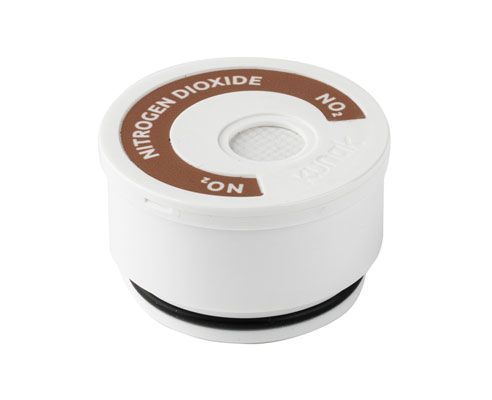Nitrogen dioxide
Reliable real-time
data on NO2
GasPlug TECHNOLOGY | PATENTED DESIGN

Where is it found?
The major source of NO2 is the combustion of fossil fuels: coal, oil and gas. Most of the NO2 in cities is derived from motor vehicle exhausts.
Other sources of NO2 are petrol and metal refining, electricity generation from coal-fired power stations, other manufacturing industries and food processing.
Why is it harmful?
Nitrogen dioxide (NO2) is a pollutant criterion that contri- butes to the formation of photochemical smog, which has significant impact on human health.
Breathing increased levels of NO2 inflames the lining of the lungs and reduces immunity to lung infections. The result is wheezing, coughing, colds, flu and bronchitis, as well as more frequent and intense asthma attacks.
NO2 cartridge
The nitrogen dioxide cartridge contains an electrochemical sensor with an embedded O3 filter, which eliminates the interferences produced by ozone, making the cartridge ideal for measuring the concentrations found in the atmosphere that vary from very low levels in clean environments to high concentrations in polluted areas of cities or industries.
The new Kunak algorithm corrects the effects of temperature and humidity in this cartridge, significantly mitigating the effect that these sensors suffer from fast humidity transients.
Technical specifications
- Measurement range: concentration range measured by the sensor.
- Resolution: smallest unit of measurement that can be indicated by the sensor.
- Operating temperature range: temperature interval at which the sensor is rated to operate safely and provide measurements. (**) In PM sensor Type A: -40 to 50ºC with heater (more information on this version on request).
- Operating RH range: humidity interval at which the sensor is rated to operate safely and provide measurements.
- Recommended RH range: Recommended relative humidity range for optimal sensor performance. Continuous exposure outside the recommended range may damage the cartridge.
- Operating life: time period during which the sensor can operate effectively and accurately under normal conditions.
- Guarantee range: concentration range covered by Kunak's guarantee.
- LOD (Limit Of Detection): measured at laboratory conditions at 20ºC and 50% RH. The limit of detection is the minimum concentration that can be detected as significantly different at zero gas concentration, calculated according to the Technical Specification CEN/TS 17660.
- Repeatability: measured at laboratory conditions at 20ºC and 50% RH. Closeness of the agreement between the results of successive measurements of the same measure carried out under the same conditions of measurement, calculated according to the Technical Specification CEN/TS 17660.
- Response time: time needed by the sensor to reach 90% of the final stable value.
- Typical precision - R2: statistics obtained between the device hourly measurements and reference instruments in field test between -10 to +30ºC at different locations. (*) For the type B PM sensor, the expected error for PM10 is higher in presence of coarse particles.
- Typical accuracy: for criteria pollutants is the average Mean Absolute Error (MAE) obtained between the device hourly measurements and reference instruments for 1 to 8 months field test between -10 to +30ºC in different countries. For other pollutants is the expected error of the measurement at the reading.
- DQO-Typical U(exp): Data Quality Objetive expresed as the Expanded Uncertainity in the Limit Value obtained between the device hourly measurements and reference instruments for 1 to 8 months field test between -10 to +30ºC in different countries, calculated according to the European Air Quality Directive 2024/2881 and from the Technical Specification CEN/TS 17660. (*) For the type B PM sensor, the expected error for PM10 is higher in presence of coarse particles.
- Typical intra-model variability: calculated as the standard deviation of the three sensor means in 1 to 8 months field test between -10 to +30ºC in different countries.
A, B, C, D superindex: the super indexes refer to different types of cartridges related to the same target pollutant but with different technical specifications.


